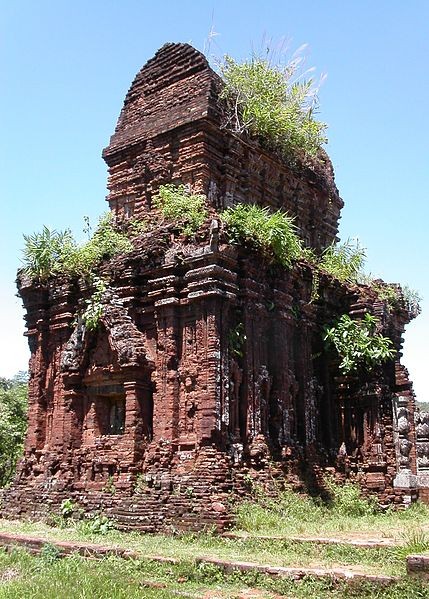(VOVworld) – The Cham tower of the ancient Champa Kingdom is typical of Hindu architecture. In Vietnam, there are about 50 Cham towers scattered along the central coast. Historians say the newest towers are 5 to 6 hundred years old and the oldest might be thousands of years old.
 |
| A Cham tower in My Son sanctuary (Photo: wikipedia) |
Driving through Vietnam’s central region from the Ngang Pass to Phan Thiet, one can see a number of golden brown multi-storey Cham towers topped with intricate shapes. If the Angkor Wat temple and Bayonne tower in Cambodia and other temples in Indonesia and India are made of stone, the Cham towers in Vietnam are made of brick, which have endured until today. Intricate patterns of flowers, leaves, birds and dancing girls are carved on the bricks, a rare thing in architecture. Professor Ngo Van Doanh from the Institute for Southeast Asian Studies said calls the Cham people “masters of brick construction”: “A normal brick house might last a century at most. But Cham towers are at least 7-8 hundred years old and some are more than one thousand years old. Obviously, they were built of bricks but no brick seams are found. Subtle patterns are carved on the brick walls. These techniques of stacking bricks tightly together and carving on the bricks apparently only existed in the Champa Kingdom, and nowhere else in Southeast Asia or in the world”.
Vietnamese researchers in collaboration with experts from Poland, France, and Italy have studied 50 Cham towers and say although Cham bricks are made of normal clay, they display exceptional features due to the kneading techniques. Professor Doanh compares Cham bricks with today’s ordinary bricks: “The Cham bricks are very different from ours. In the central region, we use the same clay there to produce bricks, but the results are different. Between the two bricks of the same size, the Cham brick is lighter. For example, an ordinary brick weighs 2kg. The Cham brick weighs only between 1.5kg and 1.6kg. Cham brick is spongy, light and plastic, while our brick is hard and easily broken”.
My Son sanctuary in Quang Nam province is a big Cham tower relic site, recognized as a world heritage site by UNESCO in 1999. If you see some bricks held together with cement or clay, they probably were added in 1984 to help protect the original tower. Le Xuan Tien, who works at the My Son sanctuary, told VOV: “In 2005, Vietnamese and Milan University experts experimented with making new bricks and found that the quality of the new bricks was only one-fifth of the original Cham bricks. On the Cham tower walls, moss only grows on broken bricks. The original bricks were coated with a special kind paint, which was much better than today’s paint”.